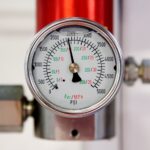Understanding the intricacies of your hot water expansion tank might seem daunting, but it is crucial for the smooth operation of your water heating system. Ignoring potential problems can result in significant inefficiencies and, ultimately, costly repairs. Dive into the essential aspects of identifying, testing, and replacing problematic tanks. This guide sheds light on these critical operations, making them accessible and straightforward.
- Recognize the signs: Learn the key indicators of a malfunctioning expansion tank to prevent further damage.
- Diagnose with confidence: Discover the procedures for effectively testing your tank for pressure issues, leaks, and structural concerns.
- Replace efficiently: Follow our step-by-step guide to ensure a smooth and effective tank replacement, minimizing disruption to your hot water system.
By the end of this article, you’ll be equipped with the knowledge to maintain your hot water system’s efficiency and safety, ensuring its long-term reliability. Embrace proactive maintenance today for a worry-free tomorrow.
Recognizing Hot Water Expansion Tank Problems: Testing and Replacement Steps
Before embarking on any repair or replacement of your hot water expansion tank, it is crucial to recognize the indicators of a malfunctioning system. Knowing these symptoms can help you address issues early and avoid further complications in your water heating system.
A common issue to watch for is fluctuating water pressure in your hot water system. If you notice a sudden drop in water pressure, it might be a sign of an issue with the expansion tank. Similarly, consistent leaks or moisture accumulation around the expansion tank may indicate internal failures.
Another critical sign is unusual noises, such as banging or gurgling sounds, emanating from your plumbing system. These noises often result from problems in the expansion tank or air being trapped within the system. Ignoring these signs can lead to more serious issues, such as water heater damage or inefficient operation.
Ensuring systematic monitoring of these symptoms enables you to maintain an efficient and reliable water heating setup. Addressing potential hot water expansion tank problems promptly increases your system’s lifespan and safety.
Testing Your Hot Water Expansion Tank: Diagnosing Issues
Once you have identified potential symptoms, the next step is to conduct a thorough test of your hot water expansion tank. This testing is vital to diagnose specific issues accurately and effectively. Begin by checking the tank’s pressure levels, as incorrect pressure can lead to various operational problems.
To test the pressure, you will need a reliable pressure gauge. First, disconnect the power supply and shut off the water source to ensure safety. Connect the gauge to the tank’s air valve, commonly located on top, and compare the findings to manufacturer specifications. Discrepancies in pressure readings can indicate a failing tank.
Next, inspect the tank for any signs of leaks or structural damage. A visual inspection can reveal corrosion or physical cracks, which compromise the tank’s integrity. Should you find any leaks, it’s crucial to perform an immediate review as this could lead to more severe water damage or air infiltration.
By using these diagnostic steps, you will accurately identify the issues affecting your hot water expansion tank. With a clear diagnosis, you can proceed with the most appropriate solutions to maintain efficiency and system performance.
Replacing Your Hot Water Expansion Tank: Steps for a Smooth Transition
Your hot water expansion tank plays a crucial role in maintaining system pressure and preventing damage. When testing reveals irreversible damage, replacing the expansion tank becomes unavoidable. This process, although straightforward, requires careful attention to detail to minimize disruption and ensure system efficiency.
Firstly, you need to gather the necessary tools and materials. This typically includes a new expansion tank, a wrench, Teflon tape, and possibly a bucket to catch any water spills. Confirm the specifications of your existing tank to ensure the new one is a suitable match for your system.
With everything ready, turn off the water supply and the power source to your water heater. Safety should always be a top priority, so double-check that the power is completely off before proceeding.
Next, relieve the pressure in the system. Open a hot water tap until the water flow ceases, ensuring that there is no excessive pressure left in the pipes. This step is vital to avoid water splashing or system damage during tank removal.
Carefully disconnect the old expansion tank. Using your wrench, unscrew the tank by turning it counterclockwise. Be prepared for minor water spillage; hence, keep your bucket handy.
Once the old tank is removed, prepare the new expansion tank. Apply Teflon tape to the threaded fitting to ensure a tight and leak-free connection.
Install the new expansion tank by screwing it into place. Tighten it securely with a wrench, ensuring it’s aligned correctly but be cautious not to over-tighten, as this can cause damage.
Once the new tank is in place, resume your system operations. Turn on the water supply and restore power to the water heater. Carefully monitor the system for the next few hours to ensure everything is functioning correctly, checking for any leaks around the new installation.
Finally, conduct a performance check to ensure operational efficiency. Let the system reach its normal operating pressure and temperature, and then inspect again for stability and security.
Replacing a hot water expansion tank is crucial for maintaining the effectiveness and safety of your water heating system. By following these steps thoughtfully, you guarantee not only a return to normalcy but also prolonged appliance lifespan. Proactive replacement contributes to reduced maintenance issues and enhanced energy efficiency, safeguarding your investment in the long run.
Frequently Asked Questions About Hot Water Expansion Tanks
What are the signs of a malfunctioning hot water expansion tank?
Common signs include fluctuating water pressure, unusual noises, and leaks around the tank.
How often should I test my hot water expansion tank?
It is recommended to test your expansion tank every 6 to 12 months to ensure optimal performance.
Can I test the expansion tank myself?
Yes, you can perform basic tests like checking the air pressure with a gauge and inspecting for leaks.
What pressure level should my expansion tank be set to?
The pressure should usually match your home’s water pressure, typically around 40-60 PSI, but check the manufacturer’s specifications.
When should I replace my hot water expansion tank?
Replace the tank if it has significant leaks, corrosion, or if testing indicates irreparable pressure imbalance.





